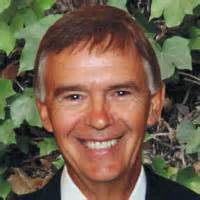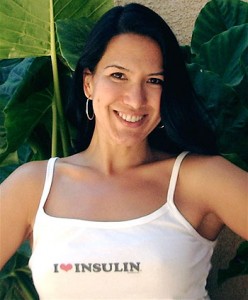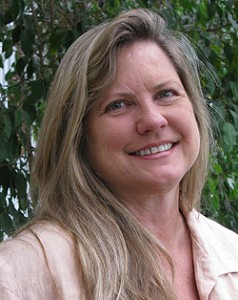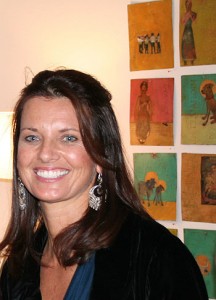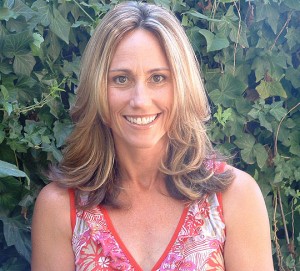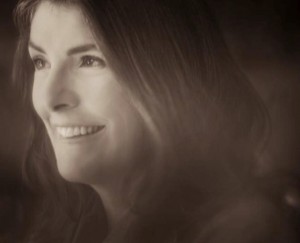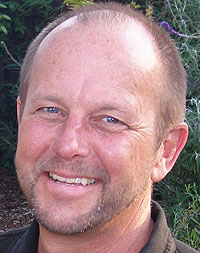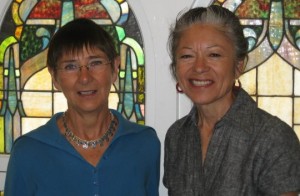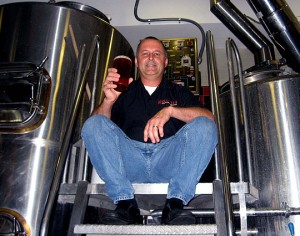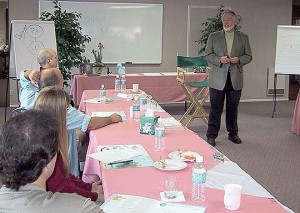
Clay Nelson walks workshop clients through the steps necessary to achieve purpose, personal and business planning, fun, effective delegation through team management, and accountability. (Clay Nelson Life Balance™ photo)
Life Coach Clay Nelson has been working with businesses and individuals to improve lives for more than 25 years. Starting this week, he’ll share with Noozhawk readers his time-tested techniques for helping people and companies fulfill their potential, maximize profits, and make themselves, their clients, and their families happier.
Leslie Dinaberg: What are some of the basic ideas that you teach with Clay Nelson Life Balance(tm)?
Clay Nelson: … I’ve been teaching people for 25 years to take care of themselves first and to put their family first and to have a billing system that serves them and they understand, and to understand what margins are and to understand marketing and to understand the value of writing down what you want so you can create what’s next, just not store what you already know.
…Family comes first. Think about that. You’re on your deathbed; money can’t hug you, number one. Number two, I doubt any of your previous clients will be there, so you have to really be looking at what’s really important, and that’s family. Then who are we the roughest on? And that’s family. So I’ve been getting people straight.
A lot of what I speak on in my speaking endeavors and my radio show and my newsletter and my blog and my “Just a Thought” email bulletins is all about communication and all about hugs and all about effective listening and all about having a plan and all about getting what you want first so you can teach others.
… Plus if you’re over 40 years old nowadays, whether you like it or not, you’re a leader, everybody’s watching you. So if you’re broke, bent over, tired and your truck’s all dirty, who is going to want to follow you? So you’ve got to be healthy, you’ve got to be able to forgive on your feet, you’ve got to be able to dance with the future, you’ve be able to stand around and say “I don’t know but let’s get it on because that’s what we do.” Then everybody dies at the end. (Laughs).
LD: It seems like now, as opposed to 25 years ago, people are starting to get that idea that it’s not just about how you are in the office, it’s about how you are in life. But I would imagine when you started out that was not something that everybody bought into.
CN: No, 25 years ago people would listen to me and go what planet did you come from? But now people want to hear what I have to say. My speaking career has tripled in the last 15 months. And you know the truth is what I’m saying now just has a different title, but what I’m saying I said 25 years ago, and it’s not about how cool Clay is, it’s just what human beings need to be with each other.
I mean stop being jerks. And if you don’t like what you’ve got, plan to have something different. And if somebody’s got something more than you got, take them to lunch, ask them how they did it and then be quiet. They’ll tell you.
LD: So what will the column for Noozhawk be about?
CN: The column is going to be talking about how you can have what you want, talking about planning, talking about forgiveness, talking about health, talking about how we merge all of it together, your spiritual side, your financial side, your family side and everything else all together because that’s what it’s all about.
… Life is all about the choices that you make. Everybody talks about how they were influenced one way or another and the truth is you may be influenced but the choice you made was yours … You are the only person that has a say in how your life turns out. So if you don’t have what you want or if you don’t have the health you want or if you don’t have the relationship you want or if you don’t have the money you want, you can change it because you did it.
… There is no past eraser, all you can do is learn from it and if it felt good and didn’t hurt anybody, do it again. (Laughs) If it didn’t feel good or it hurt somebody, say you’re sorry and don’t do it again. And that’s life. There isn’t anything else.
LD: That’s powerful.
CN: I mean what else can you do? You know if you want to live from feeling bad for what you did, okay. But it’s in the past, you can’t change it. You can only learn from it.
LD: It sounds like what you’re talking about would have an application for almost anybody.
CN: Anybody. If you’re over eight and you can read, all the way up to 80 and you still want to read. I don’t care who it is, male or female, we’re all the same.
LD: And when you’re preparing to speak to a group of teenagers versus a group of contractors, are the basics the same or are they different?
CN: I think where I want to leave them is the same, in that they are the only person that has a say in how their life turns out, and if there’s something driving them from their past they have to forgive it, make room for it, if they don’t whatever stays in their conscious mind the longest they become.
… My biggest problem with the talks I give is I’ll get in trouble either with the Fire Marshall, because there are too many people who want in the room, or I get in trouble with the next speaker that is coming in because nobody wants to leave. They come up to me and say the same thing; you were talking just to me.
LD: That’s great that you can connect with people in that way.
CN: Yeah. They get that I’ve lived where they are and I’m not telling them to go change or fix anything, I’m saying, “hey, if you don’t have what you want, choose something and get moving. ”
… The human mind is a wonderful tool, but it’s designed to keep you safe, and safe lives in something you’ve already done. Or the past. So if your mind is designed to keep you in the past, if you think about stuff do you think your mind is going to let you step out there and do something you haven’t done? No, your mind’s going to say you’re going to die, your mom’s going to be mad at you, you’re going to prison, you’ll have to eat worms, your pants are going to drop off. (Laughs). I don’t know, whatever it is, whatever it takes to stop you your mind will do. So I live my life with enough fear in it so that the hair stands up on my arms all the time, but not so much fear that I get stopped. So I want to have just enough fear to feel alive, but not so much fear that I have to be stopped. And if there isn’t enough fear to have my hairs stand up on my arms, I go make some because that’s life.
Also it keeps me from bending my elbow and putting too much food in my mouth.
LD: I can’t wait to see what you do on Noozhawk. How long have you been in Santa Barbara?
CN: For 31 years.
LD: What else do you do when you’re not working?
CN: I love to go fishing and not talk. … I have a Harley that I ride and you don’t talk on the phone when you’re on that thing. … I love to garden. … I have Hitch, my new 9-month-old English bulldog who is my best friend. No matter what I do it’s okay with him. We go to the beach two and three times a week so it gets me out more and away from the telephone and I get to play with him. I’ve been married for 24 years, living together for 30 years and I’ve almost lived through the hormone change. I get to know whether I’m going to live or die first thing in the morning. That’s supposed to be humorous.
LD: It’s too close to be humorous. If you could pick three adjectives to describe yourself, what would they be?
CN: Intuitive, unstoppable, energized-that assumes I know what an adjective is, by the way.
Vital Stats: Clay Nelson
Born: “On April 28, 1944 in El Paso, Texas in an airplane with my twin sister. My mom was flying from the East Coast to the West Coast; my dad was building Camp Roberts. … They had to put the plane down in El Paso because the twins were born on the plane.”
Family: Wife Susan Oyloe Nelson; Audre, age 36, lives in Santa Cruz, and is getting her Ph.D. in psychology; Elizabeth, age 22, attended Fashion Institute of Design and Merchandising and is now working for Jacqua Beauty in Carpinteria; C.J., age 17, is a senior at Dos Pueblos, and taking classes at SBCC.
Civic Involvement: His own 501(c)3 Transforming America’s Youth (TAY), Special Olympics, Unity Shoppe, Safe Harley Riders, Toys for Tots Ride
Professional Accomplishments: 30 years of corporate leadership, founder of Clay Nelson Life Balance(tm), a division of Consulting Services Network LLC.
Little-Known Fact: “My secret desire is to build a go-cart out of a Harley engine I have in my garage.”
Originally published in Noozhawk on November 11, 2008. Click here to read the article on that site.

